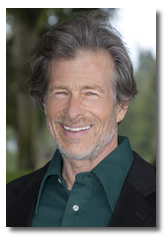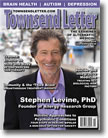|
Page 1, 2, 3
The nutritional supplement business was poised for explosive growth in 1980 when Stephen A. Levine founded Allergy Research Group in California.
 The growth was propelled by large forces. In 1970, Linus Pauling, a Nobel laureate, published Vitamin C and the Common Cold, expanding scientific thinking about all vitamins. In 1971, James Reston, America's most influential print journalist, wrote approvingly in the New York Times about his experience with acupuncture in China; the article was a first encounter, for many people, with alternative modes of healing. In 1975, historian Ivan Illich published Medical Nemesis, a seminal and convincing attack on conventional medicine, much in tune with America's willingness in the 1970s to question established institutions. The growth was propelled by large forces. In 1970, Linus Pauling, a Nobel laureate, published Vitamin C and the Common Cold, expanding scientific thinking about all vitamins. In 1971, James Reston, America's most influential print journalist, wrote approvingly in the New York Times about his experience with acupuncture in China; the article was a first encounter, for many people, with alternative modes of healing. In 1975, historian Ivan Illich published Medical Nemesis, a seminal and convincing attack on conventional medicine, much in tune with America's willingness in the 1970s to question established institutions.
Allergy Research Group started small. Among its first products were selenium, buffered vitamin C, a B complex, and a few others, sold by Levine from the trunk of his car, mostly to doctors and mom-and-pop health food stores. Today the company markets more than 200 items globally from its headquarters in the San Francisco Bay Area, and is widely respected for its innovation and high quality.
Levine holds a doctorate in molecular genetics from the University of California at Berkeley. He made a major scholarly contribution to alternative medicine in 1985 with publication of Antioxidant Adaptation: Its Role in Free Radical Pathology, coauthored with Parris M. Kidd, PhD. The book is a founding text of nutritional medicine – the first solid scientific volume to connect the dots on how free radical chemistry applies to disease and clinical medicine. He has published more than a dozen scholarly papers.
Allergy Research Group also sells products under the name NutriCology. Levine sold ARG to a large multinational firm in 2008. He continues to serve the company by directing research and product development from his home in the Pacific Northwest.
BF: Stephen, I want to begin with a devil's advocate question. Certain people say the following: "Of course Stephen Levine endorses supplements! He has a vested economic interest in them! He gets money for every supplement that ARG sells!" Your response?
SL: I take supplements because I believe in them. I believe in them because I've studied them. I'm fascinated by their efficacy and their potential. Over decades of personal and professional experience, I have been impressed innumerable times by their benefits.
The science strongly supports my opinion. Much of nutritional medicine has become evidence based. I think that the field has more real science behind it than the drug companies. But the media tries to portray us as soft-headed nerds marketing nonsense.
BF: Please mention a product made by Allergy Research Group that you're excited about, that you take daily, that's worthy of greater attention.
SL: Germanium sesquioxide. I take 300 or 400 milligrams 2 times a day in powder form.
It has major immune-regulatory effects. It's adaptogenic for the cardiovascular system and blood pressure. It has oxygen-enhancing effects. It can have analgesic effects at somewhat higher doses; that is, pain-reducing effects. Cancer patients have used it successfully for pain relief. It's nontoxic at reasonable doses.
BF: Please tell the germanium story, starting with when you first heard of it, as a tutorial on the creation and marketing of a successful nutritional supplement.
SL: I have a friend in Vancouver, Saul Pilar, MD, who called me in 1988 and said, "I've heard of this germanium sesquioxide; it's something you should look into."
I began investigating and learned about the work of a gifted Japanese researcher, a chemist named Kazuhiko Asai, who discovered that germanium occurs in high concentration in medicinal plants. Germanium comes in several forms. The form I'm talking about, to use its full name, is bis-carboxyethyl germanium sesquioxide – so-called organic germanium.
I found about 20 scientific articles on the material. The science is impressive in terms of germanium's ability to enhance the immune system and its adaptogenic and antiviral effects. I also found two very small animal studies, not formally published, documenting analgesic effects.
Around that time, I went to the dentist and had some teeth pulled rather than having root canals. Upon returning home I had a lot of pain and took a teaspoon of germanium in water. The pain was relieved almost immediately. I just had to laugh – it was so dramatic! The relief lasted just a few hours but it was striking.
I began using the product regularly. My energy was higher, in a good, clean, steady way.
I became aware of a report of liver toxicity in animals from the material, but this was retracted by the same research group when they found that the germanium they used was contaminated with germanium chloride and oxide. They then used pure material and no liver problems occurred. I established strong quality control testing in order to ensure that any material we would sell was pure germanium sesquioxide; we found a chemist at UC Berkeley who developed a panel of tests to rule out contamination. We use those tests to this day and have rejected some batches.
We started selling the product in late 1988 about 6 months after I first heard of it. I was the first to introduce the compound in North America. I lectured about germanium to medical groups. I was also interviewed by the Globe.
BF: The supermarket tabloid? Wasn't that kind of dicey?
SL: Yes, of course, but I must say, the people who contacted me were professional. They said, "We've heard of germanium and are interested in doing a story about it," and asked to interview me. They requested that I send them copies of all my background material, including journal citations and copies of letters from doctors. I did the interview, they published an accurate piece, and germanium was on the map.
BF: What are some other supplements you take? And practices you follow?
SL: Every morning I take an amino acid complex, Free Amino Acids, for general maintenance. I also use, at various times, a number of individual amino acids. A range of things can be done with individual aminos; for example, I use glycine for calming and glutamine for the GI tract. Good books are available about this topic.1
I take pancreatic enzymes, 4 to 6 after each meal, for digestive assistance. I also find it useful to take them in between meals; this offers various therapeutic benefits – for example, between-meal ingestion is probably good for autoimmune conditions and has other noted benefits.
Coffee enemas, and to a lesser extent chlorophyll enemas, are among the most powerful detoxifiers available, in my experience. They're wonderful as a daily defensive measure against toxicity. My thinking is that much illness today has to do with toxins. The Internet has many good recipes for coffee enemas, including one at the site of Dr. Lawrence Wilson. You should be aware that coffee enemas will deplete minerals to some degree, so you need to compensate with extra minerals.
I take 20 milligrams of melatonin in the early morning hours a couple of hours after I go to bed. I wake up and take it. I believe it provides significant immune protection and stress reduction, and protects against electromagnetics and oxidative stress. Melatonin is also used for sleep, of course. I introduced melatonin in North America in 1990 with an article in the Journal of Orthomolecular Medicine.2 There was no melatonin on the market before my introduction.
There's an interesting background anecdote here. In the early 1990s I went to a conference to hear from a group of melatonin researchers including Russel J. Reiter from the University of Texas at San Antonio. Russel and I spoke. He got very interested in my ideas, obtained a copy of my book Antioxidant Adaptation, and began to study melatonin to see if it was an antioxidant. He learned that it is indeed an antioxidant, a very powerful one, and his research went off in a whole new direction. He has become probably the most accomplished melatonin researcher in the world because of his studies of the antioxidant effects of the material.3
BF: As you know, some doctors who endorse melatonin recommend doses in the range of 1 to 3 milligrams nightly. And some doctors don't recommend it at all.
SL: The physiological dose is much lower than 20 mg, it's down toward 1 mg or less. Is 20 milligrams the best for a majority of patients? I don't know, but I like the antistress, antioxidant, anti-inflammatory, EMF-protective aspects of the higher dose. Melatonin bears similarity to vitamin C in that you can dramatically increase the dose with general safety.
When I introduced melatonin I offered a low dose and also a 20 mg dose because of the value of higher doses.
There have been many advances in melatonin research in recent years. For example, it has been shown to be a useful adjunct for cancer patients being treated with chemotherapy or radiation. There's a good paper on this subject titled "The Efficacy and Safety of Melatonin in Concurrent Chemotherapy or Radiotherapy for Solid Tumors."4
BF: Let's say a friend calls you and says, "Steve, I've been diagnosed with cancer. You're a bright guy who has devoted a lifetime to studying health; I seek your advice." What's your response?
SL: I would first say, "I'm not a clinical doctor; legally and ethically I can't give medical advice." I might be willing to have a conversation with my friend from an academic perspective – from the perspective of, "Here are some topics that are widely discussed among doctors and researchers" – with, again, the caveat that I'm not a physician.
I would next say to my friend, "There are powerful natural therapies available. To choose such a therapy is a very personal decision. Treating cancer requires major medical oversight. Patients need to not only survive cancer but become cancer resistant."
I don't think that killing cancer cells is terribly difficult. There are many natural agents that can do the job, but they must be accompanied by support therapies, especially detoxification. A die-off Herxheimer reaction often occurs after these cells are killed – that is, the liberation of considerable toxicity. This needs to be addressed.
Cancer cells lack antioxidant enzymes, including the copper, zinc, and manganese forms of superoxide dismutase enzymes, and other antioxidant enzymes known as catalase and glutathione peroxidase. Cancer cells are therefore generally sensitive to free radicals and related oxidizing species. This sensitivity to oxidative free radical stress led to the use of the standard radiation and chemotherapy. These therapies kill a lot of the cancer cells because of the deficiency of the protective enzymes. But they themselves also generate massive toxicity.
IV ozone, IV vitamin C, and certain herbs, minerals, and many other compounds can kill cancer cells without themselves causing the massive toxicity. While it's true that some cancer lines have adapted by increasing their glutathione levels, overall, this generalization holds true.
I would also mention energy medicine to my friend. This involves the use of Rife-type frequency generators. This type of medicine is minimally invasive. I regard energy medicine as profound. Energy medicine would be the talk of the day if Royal Rife's technology hadn't been shut down 80 years ago.
Page 1, 2, 3
|
![]()
![]()
![]()





 The growth was propelled by large forces. In 1970, Linus Pauling, a Nobel laureate, published
The growth was propelled by large forces. In 1970, Linus Pauling, a Nobel laureate, published